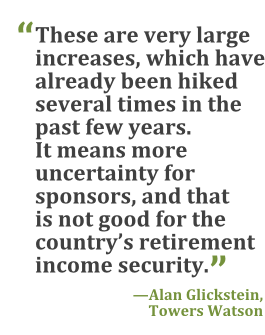The tentative budget deal reached between the Obama White House and Congressional Republicans would slap on new and significant increases to the premiums that sponsors of defined-benefit plans pay to the Pension Benefit Guaranty Corp. (PBGC).
On Tuesday, the PBGC published rate hikes for plan years beginning in 2016. The agency did not include the increases proposed in the budget deal.
The per-participant amount for the flat-rate premium was raised to $64 for next year, up from $57 in 2015. The variable rate was raised to $30 per $1,000 of unfunded liabilities, up from $24 in 2015.
 The new budget accelerates further increases, which have already nearly doubled in the past five years for single-employer plans.
The new budget accelerates further increases, which have already nearly doubled in the past five years for single-employer plans.
For plans beginning in 2017, the per-participant flat rate jumps to $68.
The year after, it increases to $73. And for plans beginning in 2019, it increases to $78.
The variable rate will be incrementally increased to $38 per $1,000 of unfunded liabilities by 2019.
“There is no good reason for Congress to go back to the same place to raise revenue and encourage more plan sponsors to de-risk their pension plans, which is exactly what these new increases will do,” said Alan Glickstein, senior retirement consultant at Towers Watson.
Glickstein said it is unclear whether or not restrictions will be placed on how the new revenue will be spent, but that it is counted as incremental revenue that will offset other spending unrelated to the country's retirement policy.
This of course is not the first time Congress has levied premium increases to raise money for the federal budget.
And that's exactly the problem, said Glickstein.
“These are very large increases, which have already been hiked several times in the past few years. It means more uncertainty for sponsors, and that is not good for the country's retirement income security issues,” he said.
Not only will the increases add further momentum to what is already an increasingly heated de-risking trend, but it will discourage the formation of new defined benefit plans, which Glickstein says still can be the right retirement option for many businesses.
He fears the deal struck between the White House and Congress indicates a “lack of awareness” of the existing pressures already motivating sponsors to de-risk pension plans.
Increasing rates of de-risking may have the negative affect of increasing liability with PBGC's single-plan insurance program; as more plans move pension liabilities to insurance companies, fewer are available to pay into the premium pool.
The new rate increases proposed in the budget deal are particularly confounding to plan sponsors, said Glickstein, given the improved status of PBGC's single-plan program of late. Recent estimates show the program's 2014 funding deficit of $19.3 billion is expected to shrink to $4.9 billion by 2024—a $3 billion improvement from estimates made just last year. That improvement is largely explained by recent premium increases. In 2014, sponsors paid $3.8 billion in premiums, up from $2.9 billion in 2013 and a record in payments to the agency.
“This isn't pension policy. It's a corporate tax,” said Glickstein. “I would hope PBGC is being forthright about the improved funding status with the single-employer program. It should be among the loudest voices defending the country's pension system.”
Glickstein said he doesn't expect material changes to the budget deal, and that it will be brought to a vote quickly.
A new survey from MetLife, which already manages $38 billion in de-risked pension liabilities, shows plan sponsors consider premium increases to PBGC as the top catalyst for considering de-risking pension plans.
That data was gleaned before the announcement of further rate increases packaged in the budget deal.
Wayne Daniel, vice president, U.S. pensions in MetLife's corporate benefit funding division, said the new rate hikes will undoubtedly increase sponsors' demand to de-risk, in what is already a “buoyant market.”
“The current budget deal will put further pressure on sponsors to de-risk,” thinks Daniel, who said U.S. sponsors have about $3 trillion in combined pension promises. About 5 percent of that has already been de-risked.
Sales of pension buyouts totaled $3.8 billion in the second quarter of 2015, a record for that period, according to the LIMRA Secure Retirement Institute.
All told, there were 62 buyout deals last quarter. The record second quarter sales is notable because the sales cycle for pension buyouts tends to be seasonal, with most activity occurring in the fourth quarter.
Daniel said he expects industry sales to be between $5 billion and $10 billion in the coming years.
© 2025 ALM Global, LLC, All Rights Reserved. Request academic re-use from www.copyright.com. All other uses, submit a request to [email protected]. For more information visit Asset & Logo Licensing.




